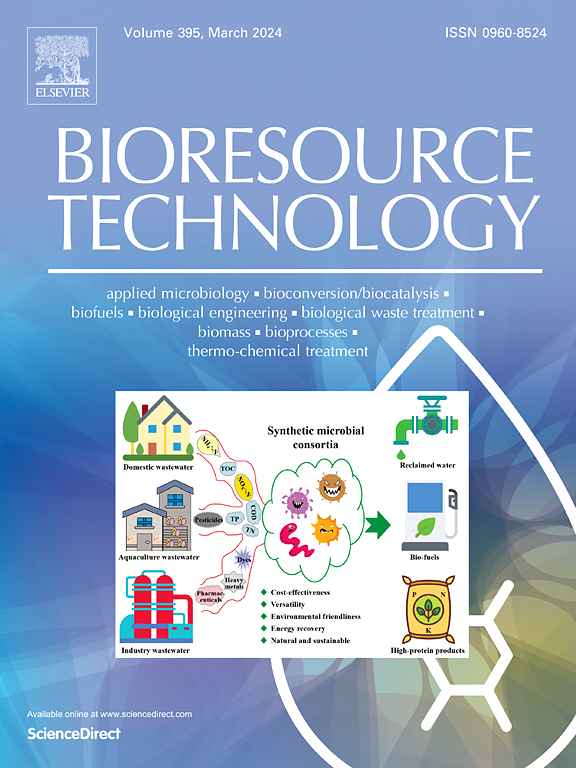Genetic redundancy of catechol 1,2-dioxygenase conferred the ability of Rhodococcus opacus PD630 for efficient catecholic compounds degradation
IF 9.7
1区 环境科学与生态学
Q1 AGRICULTURAL ENGINEERING
引用次数: 0
Abstract
Lignin, a bountiful natural resource, presents challenges in degradation and conversion due to its complex structure. Microorganisms have evolved a “biofunnel” pathway in nature that offers novel insights into lignin valorization. Among the key intermediates in lignin metabolism is catechol, predominantly metabolized by catechol 1,2-dioxygenase (CatA) in these organisms. Understanding the catechol degradation mechanism is pivotal for efficient lignin utilization. Rhodococcus opacus PD630 emerges as a promising host for lignin bioconversion, yet the gene redundancy of catechol 1,2-dioxygenase genes (catA) in this strain is not well understood, hindering a comprehensive grasp of its aromatic compound degradation pathway. This study explores the regulatory mechanisms governing the expression of catA gene duplicates, LPD06568 (catA1) and LPD06742 (catA2), in R. opacus PD630. We compared the functions of the enzymes they encode and discovered that catA2 is responsible for the degradation of excess extracellular catechol in R. opacus PD630. More interestingly, our results also showed that both of the CatAs of R. opacus PD630 could catalyze various catecholic compounds, including those with large side chain groups. Furthermore, catA1 was heterologously expressed in Streptomyces coelicolor M145 and achieved a marked cis, cis-muconic acid production (1.97 g/L) from catechol.

儿茶酚1,2-双加氧酶的遗传冗余赋予了不透明红球菌PD630有效降解儿茶酚化合物的能力
木质素是一种丰富的自然资源,由于其复杂的结构,在降解和转化方面面临着挑战。微生物在自然界中进化出一种“生物通道”途径,为木质素增值提供了新的见解。木质素代谢的关键中间体之一是儿茶酚,在这些生物中主要由儿茶酚1,2-双加氧酶(CatA)代谢。了解儿茶酚的降解机制是木质素有效利用的关键。不透明红球菌(Rhodococcus opacus) PD630是木质素生物转化的理想宿主,但该菌株中儿茶酚1,2-双加氧酶基因(catA)的基因冗余性尚不清楚,阻碍了对其芳香族化合物降解途径的全面把握。本研究探讨了数据基因重复序列LPD06568 (catA1)和LPD06742 (catA2)在R. opacus PD630中的表达调控机制。我们比较了它们编码的酶的功能,发现catA2负责R. opacus PD630中过量的细胞外儿茶酚的降解。更有趣的是,我们的研究结果还表明,R. opacus PD630的两种CatAs都可以催化各种儿茶酚化合物,包括那些具有大侧链基团的化合物。此外,catA1在冷色链霉菌M145中异种表达,并从儿茶酚中获得了显著的顺式、顺式粘膜酸产量(1.97 g/L)。
本文章由计算机程序翻译,如有差异,请以英文原文为准。
求助全文
约1分钟内获得全文
求助全文
来源期刊

Bioresource Technology
工程技术-能源与燃料
CiteScore
20.80
自引率
19.30%
发文量
2013
审稿时长
12 days
期刊介绍:
Bioresource Technology publishes original articles, review articles, case studies, and short communications covering the fundamentals, applications, and management of bioresource technology. The journal seeks to advance and disseminate knowledge across various areas related to biomass, biological waste treatment, bioenergy, biotransformations, bioresource systems analysis, and associated conversion or production technologies.
Topics include:
• Biofuels: liquid and gaseous biofuels production, modeling and economics
• Bioprocesses and bioproducts: biocatalysis and fermentations
• Biomass and feedstocks utilization: bioconversion of agro-industrial residues
• Environmental protection: biological waste treatment
• Thermochemical conversion of biomass: combustion, pyrolysis, gasification, catalysis.
 求助内容:
求助内容: 应助结果提醒方式:
应助结果提醒方式:


